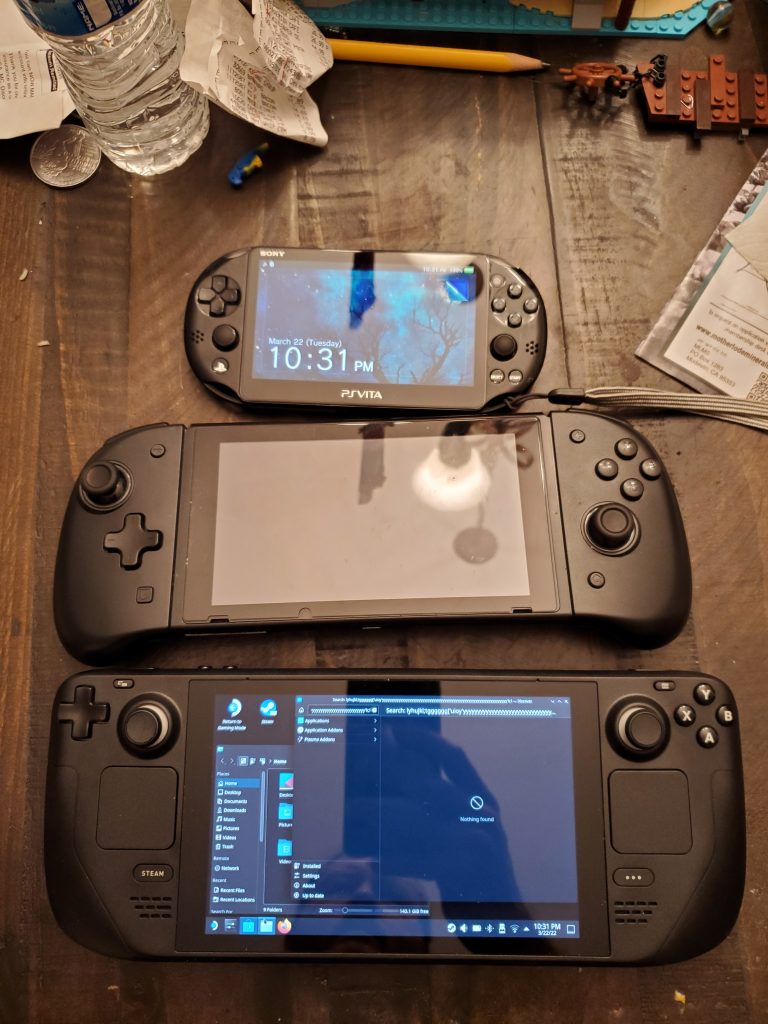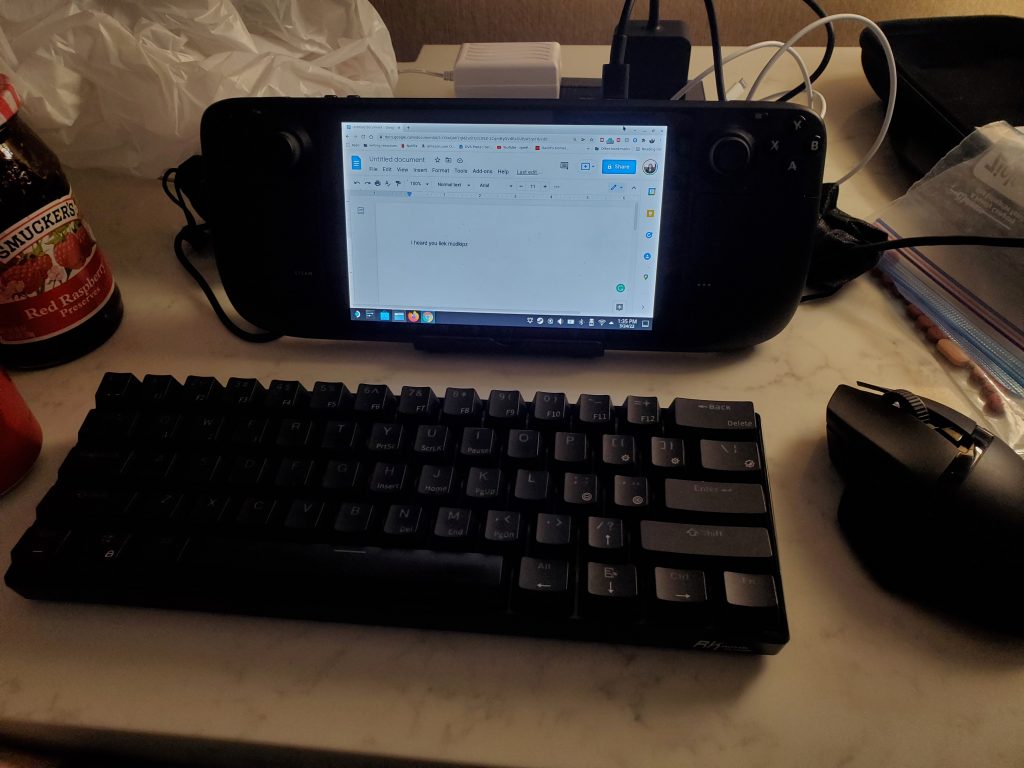Yes, I managed to get one. I pre-ordered it the first few minutes it was available and still didn’t get one until a few weeks after “launch.” That’s the world we live in right now – computer hardware is hard to get for gaming applications. I wonder if things will ever loosen up (perhaps after a few more bitcoin crashes?), or if the memory of going down to best buy and picking up a console when you decided for yourself to get one will be another one of those memories, like being able to show up to the airport a few minutes before a flight and walking on the plane without having to have your naked body scanned and your shoes x-rayed.
Siding that digression, as a gaming device, dedicated game and tech reviewers have already said plenty about the Steam Deck. I’ll add as a more regular or casual sort of gamer (these days), that the Steam Deck is an exceptional device – not just for gaming, but for productivity (as you will see). I don’t know if it will be a game-changer, but Valve did their homework and hit a niche that could grow substantially. Right now, with a Nash strategy, the gaming world is divided into four broad categories:
PC, which offers maximum performance and cutting-edge technology at a high price point and with lots of headaches and user input. The PC market drives innovation and delivers the highest-fidelity graphics but the hardware is expensive (and has gotten much more so over the last few years) and big.
Playstation/Xbox, which offers very good graphics at a modest price point and few headaches. The most competitive gaming space right now, they have since the days of the OG Xbox and PS3 offered what is essentially a managed PC experience that includes competitive online play while not requiring the user to do much if anything to get things working. The only additional hardware a user needs is a compatible TV.
Nintendo, which for the last fifteen years offered mediocre graphics at a low price point with some official gimmicks (like motion controls or 3D) to sweeten the deal. With the Switch, the big extra value in the hardware is portability, a market Nintendo has dominated for more than thirty years.
Mobile, that is phone games, which offer poor graphics, limited input control, non-traditional gameplay, and a near-zero cost entry point because most people already have a smartphone.
Naysayers in 2017 thought the switch would fail because of the dominance of the mobile phone market, which hurt both the Vita and 3DS in terms of sales. It turns out that the market was hungry for portable games that didn’t suck. The switch is also rather big, which means it’s not in the pocket like a phone, but a backpack, which makes it a device with an explicit purpose rather feeling redundant.

Enter the Steam Deck, which offers decent graphics AND portability at a modest price point by selling what is essentially a portable PC with the form-factor of a Nintendo Switch. At first glance, it seems like an odd niche. The demand for portability is already served by Nintendo, and the demand for mid-line graphics is already served by Sony and Microsoft. However, the sell of the Steam Deck is in the details which aren’t readily apparent: first, it’s a managed experience and a power-user experience in one, and second, it has a (potentially) massive game library AT LAUNCH.
In the metaphorical Nash economics of matching shaped blocks to pre-cut holes, the Steam Deck is Playdough.
On the surface, it offers a managed, low-hassle experience similar to the consoles. When you boot up the device, you are greeted with a familiar and easily navigated menu system, where you can find the games you own and also find the games which are “verified” for the hardware (more on that in a bit). Downloading, installing, and running games is as easy on the Steam Deck as the PS5, and after testing 20 or so games the only one I’ve had to tweak to get to work is Final Fantasy XIV, and that was because of an update to Square-Enix’s launcher and the fact that I don’t own the game through the Steam platform. If you treated the Deck as a Steam console, it works just like you would imagine.

But waiting below the surface is a full Linux experience, which means you can run software from other sources, browse the web, and even write and publish articles like this. All you have to do is activate desktop mode in the power options in the menu (and technically not even that every time-you can add software like browsers to Steam). Right now I have the Deck sitting on a stand (the spare gamepad stand that came with my Wii U, which is coincidentally perfect) and I’m typing on my Royal Kludge 61 key Bluetooth keyboard and using a Razer BT mouse. All told, it takes up less volume than my laptop and offers a better typing experience because my keyboard is mechanical, loaded with blue switches.
The screen is small, probably too small for large tasks, but the deck, like the Switch, outputs video with a USB-c dock, so you could hook it up to an external monitor or TV on the go, or even use it on a limited desk setup. I usually don’t do a lot of computing that requires heavy-lifting when I’m on the road (such as editing video or designing book covers), so that means for me I could leave my laptop at home for some trips, and use my Deck to work on my current book or update my web pages. I’m sure in the future we’ll find out just how far the hardware can be taken in terms of productivity. Personally, I’d like to see what I can do with audio and music production.

Aside from the productivity uses, the Linux back-end offers power users one of the big selling points of the PC: modding and customization. It’s more work than windows, to be sure, but it is possible to run Skyrim mods and enjoy that robust experience on the road. It’s also possible, as I mentioned, to play Final Fantasy XIV on the go. That’s big. There are precious few portable options for a full-featured MMO. The closest I’ve used prior to this was remote play on either the Vita or my Phone, which are both sub-optimal experiences and require a huge number of things to work perfectly for the game to be playable. Just a little hiccup in the long chain of servers between the user and the processing hardware can mean character death.
This, ultimately, is why streaming games is still not ascendant, and why it likely won’t ever be. While the internet itself is robust, a single user’s ability to fully utilize it is fragile. The Steam Deck can still stream from your PC (and works well, especially within a home network), but it also has the hardware inside to run demanding games – and the Steam Deck supports lots of them.
Malleable roll aside, the overlooked sell of the Steam Deck is, oddly enough, games. Buying a console is really buying access to games, not buying hardware per se (and buying hardware is, in general, getting access to important software), and the Steam Deck, if you consider it a console, launched with the biggest software library in gaming history. Not just a launch library, which is usually quite anemic (I think the SNES launched with just a handful of games), but a massive library of past games. Buying a Steam Deck means buying handheld access to all of the games you’ve ever bought on the platform, or the PC in general.
You don’t have to wait for some remaster to buy a past franchise on the Deck, either, you can just play your old version right now (even modded, if you want to take the trouble). Microsoft, in particular, has emphasized backward compatibility with its consoles, but it’s nothing compared to Valve’s offering.
At least, potentially.
The problem is, as of this writing, that not all of those games are compatible. There are plenty that just don’t work (yet). Final Fantasy XIV requires some annoying behind-the-scenes tinkering. Others are “untested” and you are rolling the dice as to whether things will work or not. Still, when I booted up my system for the first time I found that I had 26 “verified” games already in my library, some of which I had never played (there are many “new” games on the list, too). Compare that to my PS5, which played 90% of my PS4 library at launch, but had only a handful of new games available, and it’s roughly at parity, but I anticipate the Steam Deck will get better over time and I tested many “untested” games and found that they ran just fine. Not only that, but they all worked with the built-in controls perfectly, with no fiddling (and I haven’t really waded into the ability of the system to map controls). The reality is good, but the potential is amazing.
The last few console generations have all been about exclusives-what software can you play only on the selected platform? With the Steam Deck the answer is nothing and everything. PC exclusive games will run, but may not play nice with the controller or touchscreen. But all those games can be played on other hardware. You don’t buy the Deck to buy access to exclusives, you buy it to gain portability.
So what we are left with regarding the Steam Deck is an oddity: a very robust and versatile system that differentiates itself primarily by its own adaptability, rather than targeting a pre-existing portion of the market that was carved out 20 years ago. It’s amazing, especially at the price point, and has the potential to be even more amazing as time goes on. The more popular it becomes, the better the games will get, as a large, single hardware type means that games will be better optimized, just like on the consoles.
My only regret is buying the 256GB model. It’s too small to house many modern games, which can be north of 100GB, but I wasn’t sure I could replace the internal SSD, so I opted for a mid-priced option. Now that I know you can replace it, I wish I had got the 64GB model, lived with the loading times of my microSD card (which is plenty fast for most games), and then replaced the SSD when I could with something really big and saved a few dollars.
So there you go, an article about the Steam Deck written on the Steam Deck.
Buy my books:




